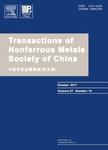Microstructure and properties of rare earth-containing Cu-Cr-Zr alloy
含稀土Cu-Cr-Zr合金的微观组织和性能(英文)作者机构:上海交通大学材料科学与工程学院金属基复合材料国家重点实验室上海200240
出 版 物:《Transactions of Nonferrous Metals Society of China》 (中国有色金属学报(英文版))
年 卷 期:2015年第25卷第4期
页 面:1206-1214页
核心收录:
学科分类:08[工学] 080502[工学-材料学] 0805[工学-材料科学与工程(可授工学、理学学位)]
基 金:Project(51227001)supported by the National Natural Science Foundation of China Project(2011CB610405)supported by the National Basic Research Program of China
主 题:Cu-Cr-Zr-RE alloy rolling aging treatment microstructure properties
摘 要:Cu-0.81Cr-0.12Zr-0.05La-0.05Y(mass fraction) alloy was successively subjected to hot rolling, solid solution treatment, cold rolling and aging treatments. Its microstructure, microhardness and electrical conductivity at different states were systematically investigated. The as-cast microstructure consists of three phases: Cu matrix, Cr and Cu5 Zr. Zr is completely dissolved into the matrix while partial Cr remains after the solid solution treatment. Aging of the cold-rolled sample makes nanocrystals of Cr and Cu5 Zr precipitate from the matrix, and the microhardness and electrical conductivity rise. A combination of high microhardness(HV 186) and high conductivity(81% IACS) can be obtained by aging the sample at 773 K for 60 min. As the aging temperature increases, the orientation degree of the Cu crystals gradually decreases to zero, but the microstrain in them cannot be eliminated completely owing to the presence of precipitates and dislocations. The Cr precipitates exhibit the N-W orientation relationship with the matrix when the coherence strengthening mechanism plays a main role.



